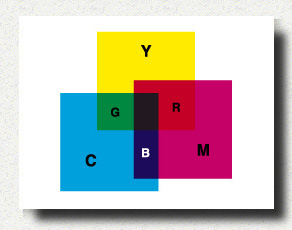Colors and Pigments
What is color?Technically speaking they characterize light like wavelength does.When light falls on any object some part is absorbed and some part is reflected.Reflected light falls on our eyes and we get the sensation of color.
 In the window alongside
I have tried to highlight the rgb color model according to which there
are only three basic colors red,green and blue.All other colors can
be made by combining them suitably. In the window alongside
I have tried to highlight the rgb color model according to which there
are only three basic colors red,green and blue.All other colors can
be made by combining them suitably. |
 Red, green, and blue are primary colors. They are the three basic pigment
colors and are also known as additive primates. These three colors
are mixed to create all other colors and can be combined with white
or black to create tints (lighter tones) and shades (darker hues) of
these colors
Red, green, and blue are primary colors. They are the three basic pigment
colors and are also known as additive primates. These three colors
are mixed to create all other colors and can be combined with white
or black to create tints (lighter tones) and shades (darker hues) of
these colors![]()
 What's a secondary color?
What's a secondary color?
 Orange, yellow, and purple are secondary colors. They are created by mixing
two of the three primary colors together.Similarly tertiary colors are made
by combining any two secondary colors.
Orange, yellow, and purple are secondary colors. They are created by mixing
two of the three primary colors together.Similarly tertiary colors are made
by combining any two secondary colors.
 Sir,I have studied in a book that yellow is considered a primary color in
the latest model and green is a secondary color.
Sir,I have studied in a book that yellow is considered a primary color in
the latest model and green is a secondary color.
 Thats true.But here we are studying thr rgb model which is widely used in
television and computer industry.Now let me tell you something about additive
mixing and subtractive mixing.The art of reproducing color by adding the
three primary RGB colors in varying proportions is called additive mixing.
This principle is used to reproduce the color in video and computer monitors.White
light is produced by mixing 100% of all three primary colors. Subtracting
red produces cyan (a mixture of blue and green). Subtracting green produces
magenta, and subtracting blue produces yellow. When an object absorbs red
and reflects blue and green, we perceive the color to be cyan. The expression
of color by subtraction of one component from white light is called subtractive
mixing.This principle is used by paints or dyes to reproduce color.In fact
this principle forms basis for anther less popular CMYK color model.The
pictures below illustrate both these principles.
Thats true.But here we are studying thr rgb model which is widely used in
television and computer industry.Now let me tell you something about additive
mixing and subtractive mixing.The art of reproducing color by adding the
three primary RGB colors in varying proportions is called additive mixing.
This principle is used to reproduce the color in video and computer monitors.White
light is produced by mixing 100% of all three primary colors. Subtracting
red produces cyan (a mixture of blue and green). Subtracting green produces
magenta, and subtracting blue produces yellow. When an object absorbs red
and reflects blue and green, we perceive the color to be cyan. The expression
of color by subtraction of one component from white light is called subtractive
mixing.This principle is used by paints or dyes to reproduce color.In fact
this principle forms basis for anther less popular CMYK color model.The
pictures below illustrate both these principles.


 Wow , that's fantastic, I can vary red green and blue between 0 and
255 and corresponding to each combination I get a different shade.
Wow , that's fantastic, I can vary red green and blue between 0 and
255 and corresponding to each combination I get a different shade.